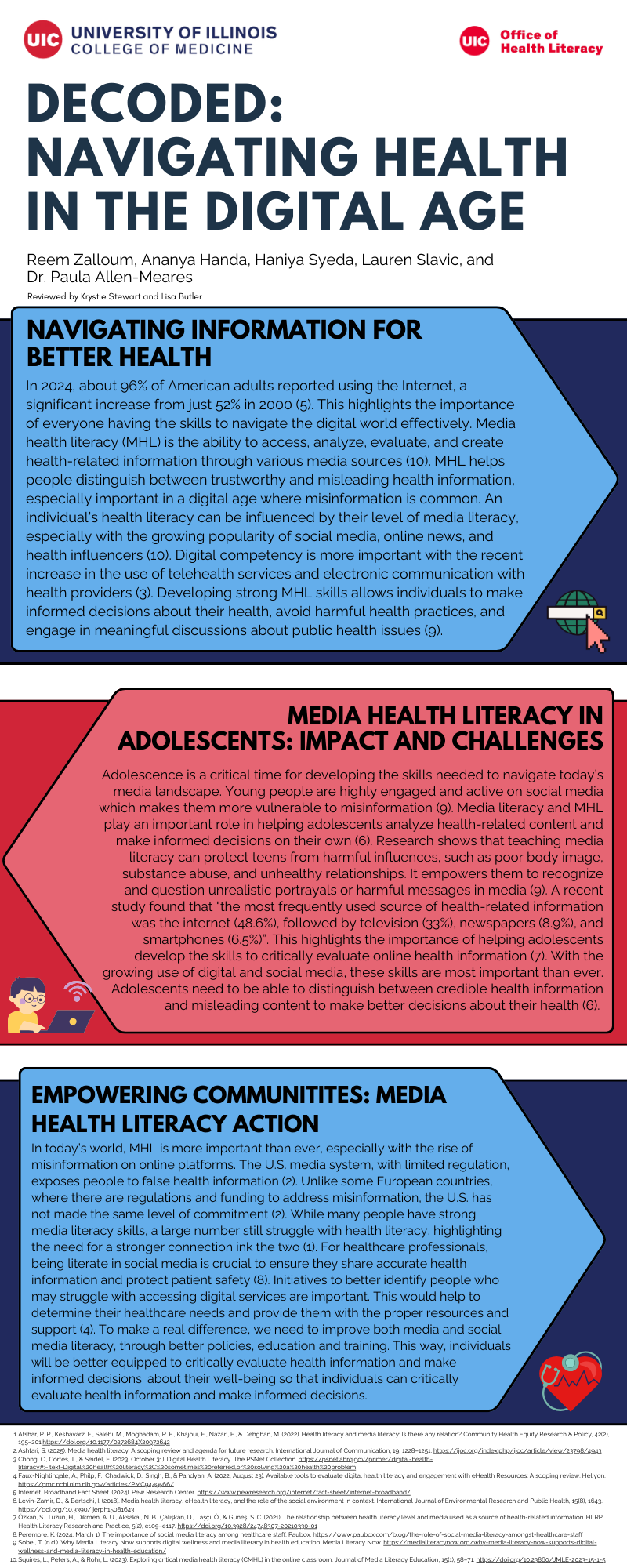Decoded: Navigating Health in the Digital Age
Reem Zalloum, Ananya Handa, Haniya Syeda, Lauren Slavic, and Dr. Paula Allen-Meares
Published April 1st, 2025. Heading link

Navigating Information for Better Health
In 2024, about 96% of American adults reported using the Internet, a significant increase from just 52% in 2000 (5). This highlights the importance of everyone having the skills to navigate the digital world effectively. Media health literacy (MHL) is the ability to access, analyze, evaluate, and create health-related information through various media sources (10). MHL helps people distinguish between trustworthy and misleading health information, especially important in a digital age where misinformation is common. An individual’s health literacy can be influenced by their level of media literacy, especially with the growing popularity of social media, online news, and health influencers (10). Digital competency is more important with the recent increase in the use of telehealth services and electronic communication with health providers (3). Developing strong MHL skills allows individuals to make informed decisions about their health, avoid harmful health practices, and engage in meaningful discussions about public health issues (9).
Media Health Literacy in Adolescents: Impact and Challenges
Adolescence is a critical time for developing the skills needed to navigate today’s media landscape. Young people are highly engaged and active on social media which makes them more vulnerable to misinformation (9). Media literacy and MHL play an important role in helping adolescents analyze health-related content and make informed decisions on their own (6). Research shows that teaching media literacy can protect teens from harmful influences, such as poor body image, substance abuse, and unhealthy relationships. It empowers them to recognize and question unrealistic portrayals or harmful messages in media (9). A recent study found that “the most frequently used source of health-related information was the internet (48.6%), followed by television (33%), newspapers (8.9%), and smartphones (6.5%)”. This highlights the importance of helping adolescents develop the skills to critically evaluate online health information (7). With the growing use of digital and social media, these skills are most important than ever. Adolescents need to be able to distinguish between credible health information and misleading content to make better decisions about their health (6).
Empowering Communities: Media Health Literacy Action
In today’s world, MHL is more important than ever, especially with the rise of misinformation on online platforms. The U.S. media system, with limited regulation, exposes people to false health information (2). Unlike some European countries, where there are regulations and funding to address misinformation, the U.S. has not made the same level of commitment (2). While many people have strong media literacy skills, a large number still struggle with health literacy, highlighting the need for a stronger connection ink the two (1). For healthcare professionals, being literate in social media is crucial to ensure they share accurate health information and protect patient safety (8). Initiatives to better identify people who may struggle with accessing digital services are important. This would help to determine their healthcare needs and provide them with the proper resources and support (4). To make a real difference, we need to improve both media and social media literacy, through better policies, education and training. This way, individuals will be better equipped to critically evaluate health information and make informed decisions. about their well-being so that individuals can critically evaluate health information and make informed decisions.
Published April 1st, 2025.
Footnotes Heading link
- Afshar, P. P., Keshavarz, F., Salehi, M., Moghadam, R. F., Khajoui, E., Nazari, F., & Dehghan, M. (2022). Health literacy and media literacy: Is there any relation? Community Health Equity Research & Policy, 42(2), 195–201. https://doi.org/10.1177/0272684X20972642
- Ashtari, S. (2025). Media health literacy: A scoping review and agenda for future research. International Journal of Communication, 19, 1228–1251. https://ijoc.org/index.php/ijoc/article/view/23798/4943
- Chong, C., Cortes, T., & Seidel, E. (2023, October 31). Digital Health Literacy. The PSNet Collection. https://psnet.ahrq.gov/primer/digital-health-literacy#:~:text=Digital%20health%20literacy%2C%20sometimes%20referred,or%20solving%20a%20health%20problem
- Faux-Nightingale, A., Philp, F., Chadwick, D., Singh, B., & Pandyan, A. (2022, August 23). Available tools to evaluate digital health literacy and engagement with eHealth Resources: A scoping review. Heliyon. https://pmc.ncbi.nlm.nih.gov/articles/PMC9449566/
- Internet, Broadband Fact Sheet. (2024). Pew Research Center. https://www.pewresearch.org/internet/fact-sheet/internet-broadband/
- Levin-Zamir, D., & Bertschi, I. (2018). Media health literacy, eHealth literacy, and the role of the social environment in context. International Journal of Environmental Research and Public Health, 15(8), 1643. https://doi.org/10.3390/ijerph15081643
- Özkan, S., Tüzün, H., Dikmen, A. U., Aksakal, N. B., Çalışkan, D., Taşçı, Ö., & Güneş, S. C. (2021). The relationship between health literacy level and media used as a source of health-related information. HLRP: Health Literacy Research and Practice, 5(2), e109–e117. https://doi.org/10.3928/24748307-20210330-01
- Peremore, K. (2024, March 1). The importance of social media literacy among healthcare staff. Paubox. https://www.paubox.com/blog/the-role-of-social-media-literacy-amongst-healthcare-staff
- Sobel, T. (n.d.). Why Media Literacy Now supports digital wellness and media literacy in health education. Media Literacy Now. https://medialiteracynow.org/why-media-literacy-now-supports-digital-wellness-and-media-literacy-in-health-education/
- Squires, L., Peters, A., & Rohr, L. (2023). Exploring critical media health literacy (CMHL) in the online classroom. Journal of Media Literacy Education, 15(1), 58–71. https://doi.org/10.23860/JMLE-2023-15-1-5